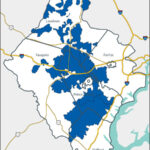
By Steve Haner
The major “rural” electric cooperative serving very urban Northern Virginia is drastically lowering its rates as of this month, because the cost it is paying for bulk power purchases has dropped. The contrast with what is happening with Virginia’s two major investor-owned electric companies may be telling Virginia something if anybody wants to listen.
NOVEC, or Northern Virginia Electric Cooperative, will be charging its residential users just under $114 for each 1,000 kilowatt hours of usage, down more than $26. The commercial and industrial users among its 175,000 customers are seeing comparable reductions.
In comparison, Dominion Energy Virginia (despite all the silly claims of bill reduction efforts in 2023) is charging residential customers about $135 for the same 1,000 kwh and has petitions pending at the State Corporation Commission to add another $10 or so to that. Appalachian Power Company, serving parts of western Virginia, was charging about $160, and as of this month that will reach about $185. Thus reported the SCC staff in a December legislative presentation.
So it will cost 25% more to get your electricity from Dominion than from NOVEC, and more than 60% more to get electrons from Appalachian. The folks largely responsible for this disparity, the Virginia General Assembly, are back on Capitol Square and you can expect more bad bills to pass that will further increase customer costs. The Appalachian rate in particular has reached a level that makes it an economic albatross.
Residential users are often clueless about what they pay (and this author is losing interest in playing Cassandra for them). You can bet economic development professionals and large customer energy managers know all these numbers by heart. This matters in picking plant or store locations as much or more than tax rules do.
Some of the difference is due to the different corporate structures of the companies. As a member-owned electric cooperative, NOVEC does not pay any dividends to outside shareholders. If it has excess revenue, members get rebates. As a not-for-profit entity, it pays no state or federal income taxes, unlike the major providers.
NOVEC builds and owns no power plants, but merely buys bulk power under contract from various producers within the PJM Interconnection regional transmission organization. As costs soared in recent years because of the Ukraine War, among other causes, NOVEC did not defer collection during the surge. Now it is able to immediately pass along the savings coming from a return to more rational pricing.
Dominion, on the other hand, did defer collection and has now imposed (with the help of legislators) a scheme to collect that back debt from its customers over several years, with massive interest costs added.
Other legislative actions are also involved. When the 2020 General Assembly passed its Virginia Clean Economy Act and related bills, the cooperatives buying in bulk from Dominion were specifically exempted from the costs of Dominion’s Coastal Virginia Offshore Wind project. There are no mandated renewable power percentages being imposed on the Virginia coops, although the folks who could ruin that are now back in the majority at the Capitol.
NOVEC is not one of the Virginia rural coops which belongs to the Old Dominion Electric Cooperative, a multi-state coalition of similar independent coops that, among other things, does have an ownership stake directly in generation facilities. One of them is large enough that for three years ODEC was forced to pay a carbon tax under the Regional Greenhouse Gas Initiative, and pass that cost along. Despite Virginia now having exited, Dominion will continue to impose RGGI costs on customers into 2024.
There is no line on the NOVEC bill reporting that customers must pay extra every month to subsidize their lower-income neighbors, the Percentage of Income Payment Program (or PIPP) now being charged to Dominion and Appalachian customers. Nor is there a monthly surcharge to cover various so-called “energy efficiency” programs seeking to use money from Ratepayer A to cover insulation or LED lightbulbs for Ratepayer B. Such charges for Dominion and Appalachian seem to grow annually, yet power demand is unabated.
More examples of legislative mandates on the major utilities which NOVEC escapes could be listed. However, NOVEC’s biggest advantage is probably its compact and fairly dense service territory.
Historically, the rural coops deal with customers strewn sparsely over a wide territory, and it wasn’t that many decades ago that this described large portions of the Northern Virginia region. NOVEC’s originally-rural footprint is now often indistinguishable from the rest of the sprawling metroplex. It enjoys the economies of scale of serving a dense, growing and economically strong customer base, without the regulatory, tax or profit mandates faced by Dominion.
With its stagnant if not shrinking economic footprint, the Appalachian territory is growing more and more similar to a massive and very inefficient electric coop. That might be a bit harsh, but the lack of economic vitality is a big factor in those rates.
If Virginia had farsighted leadership, this disparity would start an analysis about how to lower the costs of the two major providers. Mandates and regulations would be reviewed and some discarded. The leadership Virginia voters have chosen, however, will probably instead set about expanding the mandates and costs on companies such as NOVEC, and seek to close the embarrassing gap by charging its customers more.

Leave a Reply
You must be logged in to post a comment.